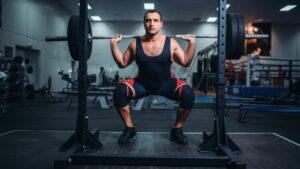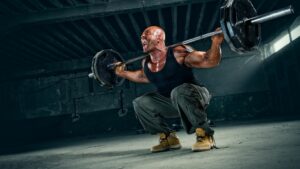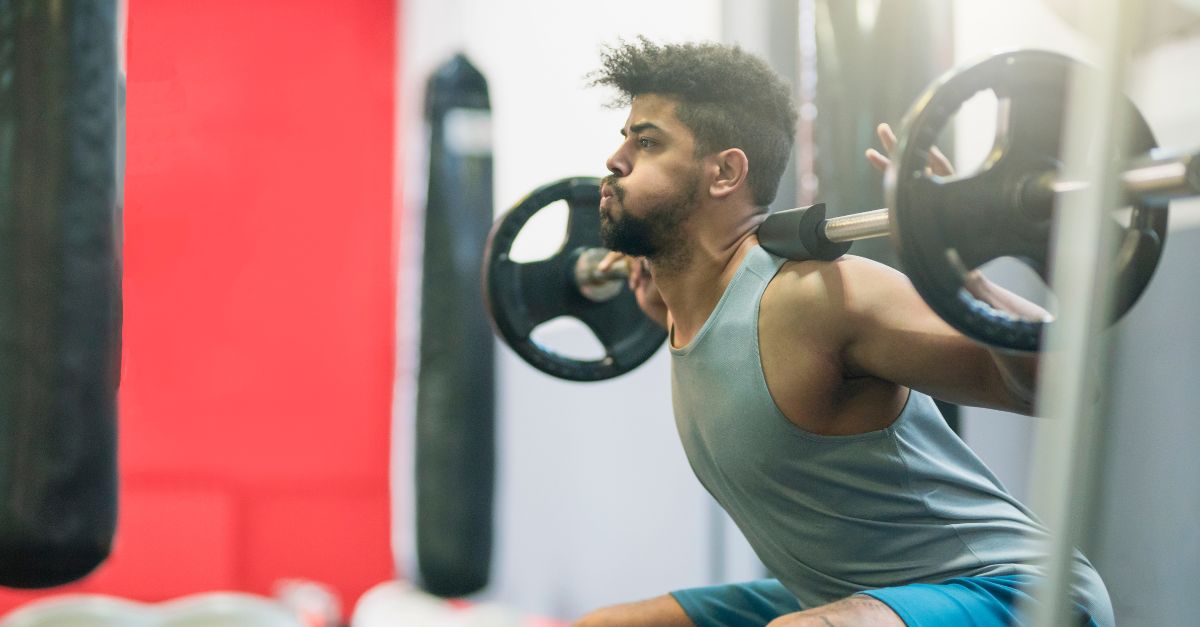Hey there, fitness enthusiasts! If you’ve ever wondered about the age-old debate of body weight versus height and how they impact your back squat performance, you’re in the right place.
We’re diving deep into this topic to uncover the secrets behind those impressive squats you see at the gym.
So, grab your workout gear and get ready for a friendly showdown between body weight and height – let’s settle this once and for all!
Understanding Which Matters More Body Weight or Height for Back Squat Performance.
The relationship between body weight and height in relation to back squat performance is an interesting topic in the field of strength training and sports science.
To provide a comprehensive answer without losing specificity or context, let’s break down the key factors at play:
Body Weight:
Body weight plays a significant role in back squat performance. Heavier individuals often have an advantage because they have more mass to move the barbell, which can help generate greater force.
Increased body weight can provide stability and support during the squat. It contributes to a stronger base and can aid in balance and control.
However, excessive body weight can also pose challenges, as it may increase the stress on joints and ligaments, potentially leading to injury if not managed properly.
Height:
Height, while less directly related to squat performance compared to body weight, can still have an impact. Taller individuals may face challenges due to longer limbs, which can affect their leverage and range of motion.
Longer limbs can make it more challenging to maintain proper squat form, and they may need to adapt their technique to accommodate their height.
Shorter individuals may have a biomechanical advantage in terms of squatting because they often have a more favorable lever system for lifting heavier weights.
Individual Variation:
It’s important to recognize that both body weight and height are just two factors among many that influence back squat performance. Individual factors like muscle mass, flexibility, training experience, and genetics play crucial roles.
Some athletes may excel in the back squat despite being tall or having lower body weight, while others may struggle despite having a weight and height advantage.

Training and Technique:
Regardless of body weight and height, the key to improving squat performance lies in proper training and technique. Developing strength, mobility, and flexibility are essential aspects of squat training.
Personalized programming and coaching can help individuals optimize their squat performance by addressing their unique body characteristics and limitations.
In other words, both body weight and height matter to some extent in back squat performance, but they interact with a range of other factors.
While body weight contributes to the ability to move heavy weights, height can influence biomechanics.
However, individual variation and training techniques play pivotal roles. The key is to focus on optimizing one’s strengths, addressing weaknesses, and constantly improving through a well-structured training program.
Further Explanations.
Let’s dive deeper and elaborate further on all the points mentioned.
Body Weight.
let’s delve deeper into the role of body weight in back squat performance:
Advantages of Heavier Body Weight:
Heavier individuals often have an advantage in back squat performance because of their increased muscle mass and overall mass. Muscle is a key factor in generating force during a squat.
When you have more body weight, there’s more mass to move the barbell, which can translate into the ability to lift heavier weights. This is particularly advantageous in strength sports like powerlifting, where lifting maximal loads is the goal.
Stability and Support:
Body weight contributes to the stability and support necessary for a successful squat. When you have more body mass, it creates a stronger base for the squat movement.
This added stability can help with balance and control during the squat, making it easier to maintain proper form and prevent deviations that could lead to injuries.
Challenges of Excessive Body Weight:
While body weight is important, there’s a point at which excessive body weight can become a disadvantage, especially if it’s primarily due to excess fat rather than muscle.
Excessive body weight, particularly in the form of body fat, can place increased stress on the joints, ligaments, and tendons, especially in the lower body. This added stress can lead to overuse injuries or chronic joint issues like knee or hip pain.
Additionally, excessive body weight can make it more challenging to perform certain aspects of the squat, such as achieving proper depth or maintaining a neutral spine position.
It’s important to note that the ideal body weight for back squat performance varies from person to person and depends on their goals. Athletes in different weight classes or sports may aim for different body compositions to optimize their squat performance.
In essense, body weight is a critical factor in back squat performance, offering advantages in generating force, stability, and support.
However, there’s a balance to strike, as excessive body weight can lead to challenges and potential injury risks.
Achieving the right body composition for one’s specific goals and optimizing strength and technique through training are key to successful back squat performance.
Height.
let’s explore the role of height in back squat performance in more detail:
Challenges for Taller Individuals:
Taller individuals may encounter unique challenges in back squatting due to their longer limbs. The primary issues they face are related to leverage and range of motion.
Longer limbs can make it more difficult to achieve proper squat depth while maintaining good form. This is because longer legs may require greater flexibility and mobility in the hips, ankles, and lower back to perform a deep squat.
The longer distance the barbell has to travel during a squat can also make the lift feel more challenging for taller individuals. They may need to exert more effort to move the weight through a larger range of motion.
Technique Adaptations:
To overcome these challenges, taller individuals often need to adapt their squat technique. This may include working on flexibility and mobility to improve their range of motion, as well as adjusting their stance width or bar placement to find a comfortable and effective squatting position.
Additionally, some taller lifters may benefit from a low-bar squat technique, which places the bar lower on the back and may better accommodate their body proportions.

Advantages for Shorter Individuals:
On the other hand, shorter individuals often have biomechanical advantages in back squatting. Their shorter limbs create a more favorable lever system, which can make it easier to lift heavier weights.
Shorter lifters may have less difficulty achieving proper squat depth and maintaining an upright torso, which are essential for efficient and safe squatting.
It’s important to note that while height can influence squat performance, it’s just one factor among many. Proper technique, strength, and mobility are critical for both tall and short individuals to optimize their squat performance.
Overall, height can impact back squat performance by affecting leverage and range of motion.
Taller individuals may face challenges related to their longer limbs, while shorter individuals may have biomechanical advantages.
Adaptations in technique and a focus on mobility and strength are essential for individuals of all heights to excel in the back squat.
let’s delve further into the significance of individual variation and the importance of training and technique in the context of back squat performance:
Individual Variation.
Muscle Mass: The amount of muscle mass an individual has significantly influences their squat performance. Muscles are responsible for generating force during the squat, so those with more muscle may have an advantage.
Flexibility: Flexibility, particularly in the hips, ankles, and lower back, is crucial for achieving proper squat depth and maintaining good form. Some individuals may naturally have greater flexibility, while others need to work on it to optimize their squat.
Training Experience: Years of training can lead to substantial improvements in squat performance. Experienced lifters often have better technique, strength, and neuromuscular coordination, allowing them to lift heavier weights.
Genetics: Genetic factors can also play a role. Some individuals may have a predisposition for muscle growth, favorable leverages, or joint health, which can impact their squat abilities.
Psychological Factors: Mental toughness, focus, and the ability to handle heavy weights under pressure can also vary among individuals and affect squat performance.
Training and Technique:
Proper Technique: Regardless of body weight and height, mastering proper squat technique is paramount. This includes maintaining a neutral spine, achieving proper depth, and keeping the knees aligned with the toes.
Strength Development: Building lower body and core strength is essential. Exercises like squats, deadlifts, lunges, and accessory movements help improve the muscles required for successful squatting.
Mobility and Flexibility: Addressing mobility limitations, especially in the hips and ankles, is crucial. Stretching and mobility exercises can enhance flexibility and range of motion.
Programming: Personalized training programs are essential. They should consider an individual’s goals, strengths, weaknesses, and any physical limitations. Progressive overload, where the weight is gradually increased over time, is a fundamental principle.
Coaching: Having a knowledgeable coach or trainer can make a substantial difference. They can provide guidance on technique, form corrections, and programming adjustments tailored to an individual’s needs.
Consistency: Consistent training over time is key to improvement. The body adapts to the stress of squatting, so regularly practicing the movement is essential.
In summary, individual variation, including factors like muscle mass, flexibility, training experience, genetics, and psychological factors, can significantly impact back squat performance.
However, regardless of these factors, focusing on proper training and technique is essential.
A personalized approach to training and coaching can help individuals optimize their squat performance by addressing their unique characteristics and limitations, ultimately leading to better results and reduced risk of injury.
A complete tabular on this topic here.
Here’s a complete table comparing the influence of body weight and height on back squat performance.
Please note that the values in the table are general trends and can vary widely among individuals.
The assessment of which factor matters more may depend on an individual’s specific goals and context.
| Factors | Body Weight | Height |
|---|---|---|
| Influence on Strength | Heavier individuals often have an advantage due to more muscle mass and force generation potential. | Taller individuals may face challenges related to leverage and range of motion, which can affect strength. Shorter individuals may have biomechanical advantages. |
| Influence on Stability | Increased body weight provides stability and support during the squat, contributing to a stronger base and better balance. | Height can influence stability, with taller individuals potentially needing more effort to maintain proper form. Shorter individuals often have a more stable base. |
| Influence on Injury Risk | Excessive body weight, especially from excess fat, can increase stress on joints and ligaments, potentially leading to injury. Proper weight management is crucial. | Taller individuals might have greater joint stress due to their longer limbs. Shorter individuals may have less joint stress but could still be at risk if form is compromised. |
| Need for Technique Adaptations | Heavier individuals may need to adapt their squat technique to accommodate their body weight. | Taller individuals often need to adapt their technique to ensure proper depth and maintain form. Shorter individuals may need less adaptation. |
| Role in Competitive Sports | In certain strength sports, being in a higher weight class may be advantageous, so body weight can be more critical. | Height can be more relevant in sports where leverage matters, such as weightlifting, where shorter lifters often have an advantage. |
| Personalized Training Focus | Focus on body composition, muscle building, and weight management may be necessary for optimal squat performance. | Emphasis on flexibility, mobility, and technique may be more critical for those with height-related challenges. |
It’s important to emphasize that individual variation plays a significant role, and a comprehensive approach to squat training should consider both body weight and height, along with other factors such as muscle mass, flexibility, and training experience. The ideal balance between body weight and height for back squat performance may vary depending on the individual’s goals and the specific demands of their sport or training program.
Conclusion.
In conclusion, both body weight and height play important roles in back squat performance, but their significance varies depending on individual factors and goals.
Body weight contributes to strength and stability, while height can influence leverage and form.
Ultimately, the ideal balance between body weight and height for optimal back squat performance depends on individual characteristics, training objectives, and the specific demands of the sport or activity.
Therefore, it’s essential to address both factors in a comprehensive training program while prioritizing proper technique and individualized training approaches.

Hey there, it’s Mike Rrsq, the Editor-in-Chief over at Jsquat.com, and I’m absolutely obsessed with all things squat fitness! I’ve been lucky enough to get some serious recognition for my work in this field. With a solid background in the fitness and wellness industry, I’ve been there right from the get-go, helping shape this website into what it is today.
You see, I’m not just the boss around here; I’m also a passionate contributor. I love sharing my insights through my articles, and trust me, they’re not your run-of-the-mill stuff. Each piece I write is a labor of love, filled with my expertise and real-world experience in the fitness universe. So, if you’re into fitness and looking for some inspiration, you’re in the right place!

